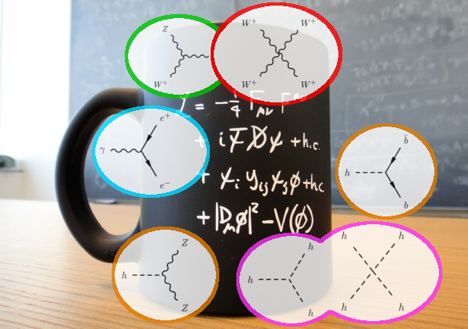Quarks observed to interact via minuscule “weak lightsabers”
5 July 2018 | By

Two among the rarest processes probed so far at the Large Hadron Collider (LHC), the scattering between W and Z bosons emitted by quarks in proton-proton collisions, have been established by the ATLAS experiment at CERN.
W and Z bosons play the same mediating role for the weak nuclear interaction as photons do for electromagnetism. As light beams of photons from torches or lasers unaffectedly penetrate each other, electromagnetic “lightsabers” will forever stay science fiction. However, beams of W and Z bosons – or “weak light rays” – can scatter from one another.
One of the key motivations for building the LHC at CERN was to study exactly this process, called weak “vector boson scattering” (VBS). One quark in each of two colliding protons has to radiate a W or a Z boson. These extremely short-lived particles are only able to fly a distance of 0.1x10-15m before transforming into other particles, and their interaction with other particles is limited to a range of 0.002x10-15m. In other words, these extremely short “weak lightsabers” extend only about 1/10th of a proton’s radius and have to approach each other by 1/500th of a proton’s radius! Such an extremely improbable coincidence happens only about once in 20,000 billion proton-proton interactions, recorded typically in one day of LHC operation.
Using 2016 data, ATLAS has now doubtlessly observed WZ and WW electroweak production, with the dominant part of it being the weak vector boson scattering: W±W± → W±W± and W±Z → W±Z. This continues the experiment’s long journey to scrutinise the VBS process: using 8 TeV data from 2012, ATLAS had obtained the first evidence for the W±W± → W±W± process with 18 candidate events. Such a yield would occur with a probability of less than 1:3000 as a pure statistical fluctuation. Now, at a higher centre-of-mass energy of 13 TeV, ATLAS has identified 60 W±W± → W±W± events, which only would happen less than once in 200 billion cases as a fluctuation from pure background processes. This corresponds to a statistical significance of 6.9 standard deviations (σ) above background. Besides the decay products of the scattered W or Z bosons, the signature of the process are two high-energetic particle jets originating from the two quarks that initially radiated the W or Z.

ATLAS has also combined 2015 and 2016 data to establish the scattering of W±Z → W±Z with a statistical significance of 5.6 σ above background. In this channel, the lower-energy data of 2012 had revealed a significance of only 1.9σ, not sufficient to claim any evidence for the process. This time, thanks to a multivariate “BDT” analysis technique implemented in 2016, ATLAS was able to isolate 44 signal candidate events, of which about half reveal “BDT score” values above 0.4, where only little background is present.
For this scattering process of vector bosons, three basic Standard Model “vertices” contribute: the interaction via the well-known “triple-boson-coupling” (green) is drastically reduced by the contributions of “quartic-boson-couplings” (red) and the “boson-Higgs-couplings” (orange). Only the latter ensures that the rate of this scattering for large centre-of-mass energies obeys the basic "unitarity" law, that a probability cannot be bigger than 100%. With the discovery of VBS, a new chapter of Standard Model tests has started, allowing ATLAS to scrutinise the so far experimentally inaccessible quartic-boson-couplings and properties of the Higgs boson.
Links:
- ICHEP2018 presentation by Rustem Ospanov: Tests of the electroweak sector with Diboson final states at the ATLAS Experiment
- ICHEP2018 presentation by Marc-Andre Pleier: New Results on Multi-Boson Production with the ATLAS Detector
- Observation of electroweak production of a same-sign W boson pair in association with two jets in proton-proton collisions at 13 TeV with the ATLAS detector (ATLAS-CONF-2018-030)
- Observation of electroweak W±Z boson pair production in association with two jets in proton-proton collisions at 13 TeV with the ATLAS detector (ATLAS-CONF-2018-033)
- Evidence of electroweak production of W±W±jj in proton-proton collisions at 8 TeV with the ATLAS detector (arXiv:1405.6241, Phys. Rev. Lett. 113 (2014) 141803)
- Measurements of W±Z production cross sections in proton-proton collisions at 8 TeV with the ATLAS detector and limits on anomalous gauge boson self-couplings (arXiv: 1603.02151, Phys. Rev. D 93 (2016) 092004)
- CMS Collaboration: Observation of electroweak production of same-sign W boson pairs in the two jet and two same-sign lepton final state in proton-proton collisions at 13 TeV (arXiv:1709.05822, Phys. Rev. Lett. 120 (2018) 081801)
- ATLAS Blog: Unread Section Opened in the Standard Model Book (2014)
- Interactions.org: Physicists Detect Process Even Rarer than the Long-Sought Higgs Particle (2014)
- Science Magazine: Had there been no Higgs boson, this observation would have been the bomb (2014)



